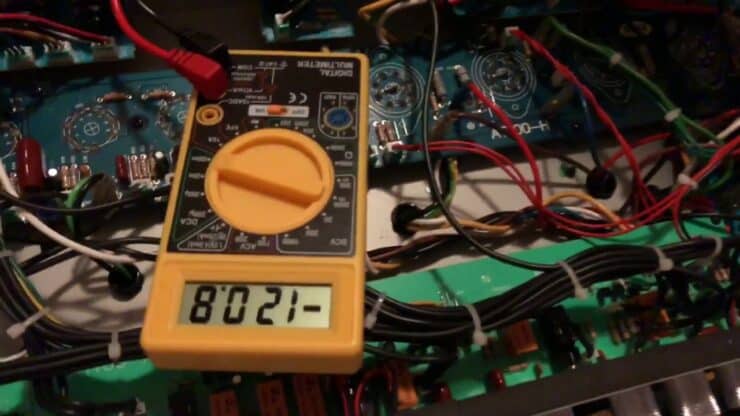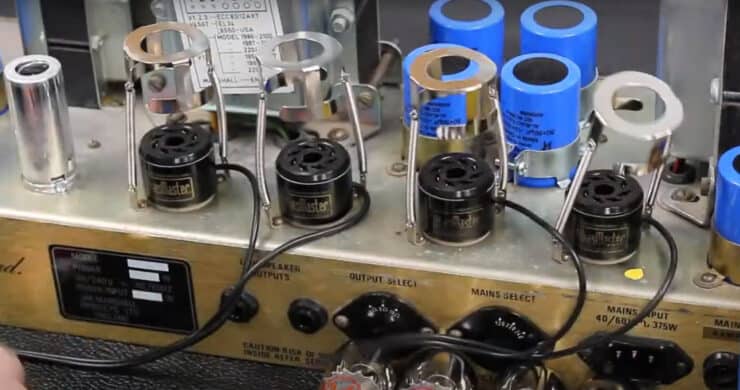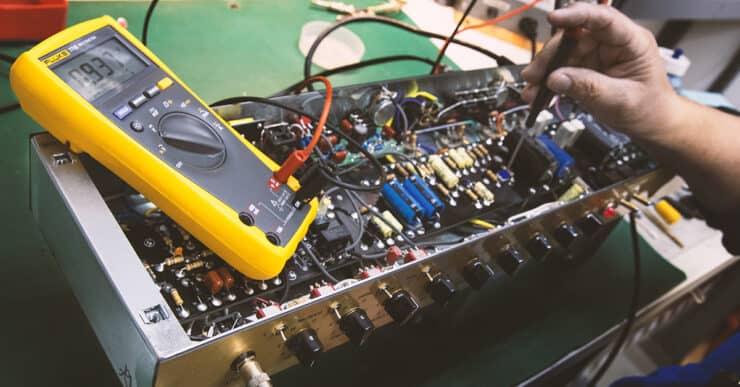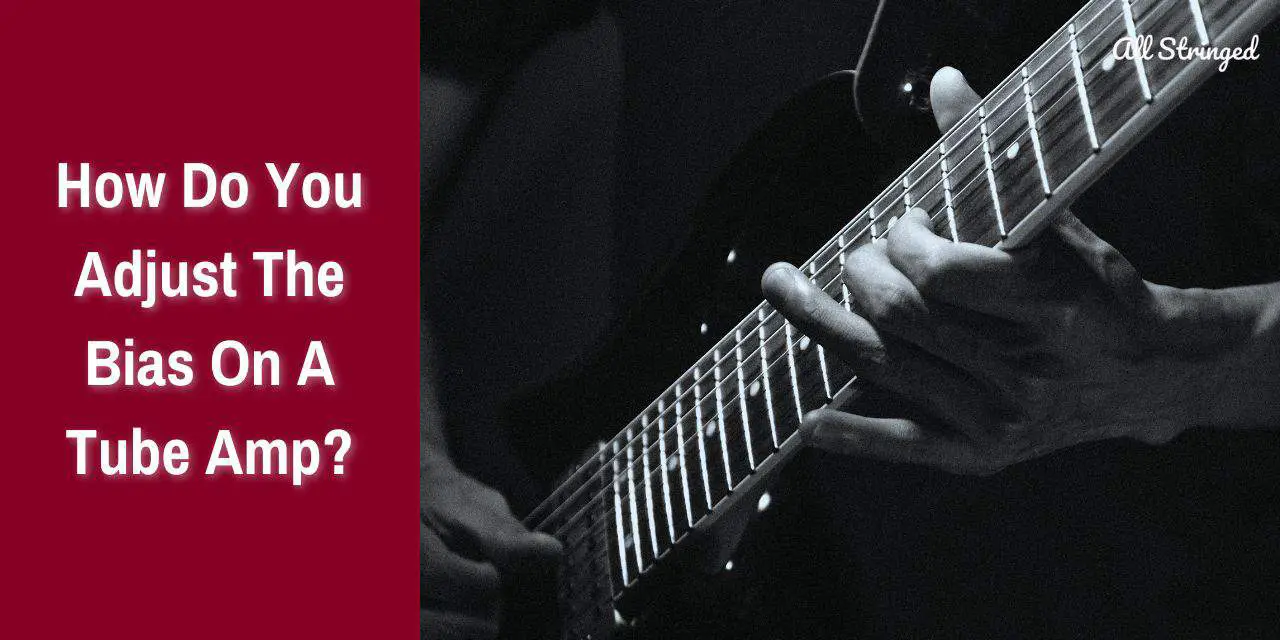Guitar players, if you’re looking to get the best, most authentic sound from your tube amp, understanding how to adjust the bias is essential. While it may sound intimidating, adjusting the bias on a tube amp is a relatively straightforward process. In this article, we’ll look at how to adjust the bias properly on a tube amp, so you can get the sound you’re after. With a few simple steps, you’ll be able to maximize the performance of your tube amp and get the wonderful sound you’ve been dreaming of. So, let’s get started!
What is bias in a tube amp?
A tube amp or also known as a valve amp is an electronic device that uses vacuum tubes for amplifying an electrical signal. Tube amps are quite popular among musicians, guitarists, and audiophiles as they’re known for producing warm and natural tones that many find pleasing to the ear. However, like any other electronic equipment, tube amps are also subject to bias, which can greatly affect the performance and overall quality of the sound they produce.
Bias is the term used for describing the amount of current flowing through the tubes in a tube amp. Proper bias is essential for maintaining the tube’s lifespan, preventing any damage to the tube amp, and ensuring optimal sound quality. The bias voltage will determine the point at which tubes operate. If the bias is too high or too low, it could cause the tubes to operate outside their ideal range.
One common bias-related issue that might arise in tube amps is a phenomenon called crossover distortion. Crossover distortion typically occurs when the bias voltage is too low, which can cause the output signal to become distorted. This type of distortion usually occurs in the crossover region, where one tube is turning off and the other is turning on. This results in a harsh, unpleasant sound that is especially noticeable when playing at low volumes.
>>> Click here to read our review about the Top 15 Best Tube Amps <<<
Another issue that might arise due to bias is thermal runaway. This occurs when the temperature of the tubes increases beyond their ideal operating range, causing an increase in current flow. This increased current flow could cause further heating of the tubes, resulting in a self-perpetuating cycle of overheating and current flow. If left unchecked, thermal runaway could cause severe damage to the amp, including the potential for fire.
To avoid these issues, it will be important to properly bias the tube amp. This can be done through a process known as biasing, which involves adjusting the voltage to the tubes to ensure they are operating at the proper range. The bias voltage can be easily adjusted using a bias probe, which measures the voltage and allows for precise adjustment.
It is important to remember that bias can vary from tube to tube, so it is essential that you check and adjust each tube individually. Moreover, the bias voltage might have to be adjusted periodically as the tubes age and their characteristics change over time.

How does bias affect the sound on a tube amp?
The sound produced by a tube amp is often considered to be warm, natural, and pleasing to the ear. This is largely due to the unique way the tube amps amplify sound, as well as the particular characteristics of the tubes themselves. However, the sound produced by a tube amp is significantly influenced by the bias voltage applied to the tubes.
First, it is important that you understand how bias works in a tube amp. Bias is the amount of current flowing through the tubes in a tube amp. The bias voltage will determine the point at which the tubes operate and if the bias is too low or too high, it could cause the tubes to operate outside the ideal range. Proper bias will be important for maintaining the lifespan of the tubes, ensuring optimal sound quality, and preventing damage to the tube amp.
But how does bias affect the sound produced by a tube amp? One of the most significant effects of bias is on the harmonic content of the sound. Harmonic content refers to the additional frequencies that are generated when a signal is amplified. In a tube amp, the bias voltage can affect the amount and type of harmonic content that is added to the sound.
When the bias voltage is set too low, the amp could suffer from crossover distortion and result in harsh, unpleasant sounds that are noticeable at lower volumes. This is because the tubes aren’t amplifying the entire waveform, resulting in an incomplete sound that lacks warmth and richness.
On the other hand, if the bias voltage is set too high, the amp can produce an overdriven, saturated sound that lacks clarity and definition. This is because the tubes are amplifying more of the signal than they need to, resulting in a sound that is overly compressed and lacks dynamics.
When the bias is set properly, the tubes amplify the entire waveform without adding any unwanted distortion or saturation. This results in a warm, natural sound that is full of harmonic content and rich in tonal character. Moreover, the sound produced by a tube amp with proper bias will be more dynamic and responsive, with a wider range of tonal variation, than an improperly biased amp.

How do you adjust the bias on a tube amp?
Adjusting the bias on a tube amp is an important part of maintaining the amp’s performance and sound quality. Proper biasing ensures that the tubes in the amp are operating within their ideal range, preventing damage to the tubes and the amp itself. Here are the steps to follow on how do you adjust the bias on a tube amp –
Step 1: Prepare the amp
Before you adjust the bias on a tube amp, it’ll be important to ensure that the amp is thoroughly prepared. This involves turning off the amp, unplugging it from the wall, and waiting for it to cool down. Once the amp is cool, you’ll be able to remove the back panel or chassis cover for accessing the tubes and the bias adjustment points. It’ll be important that you take proper safety precautions when working with the interior of a tube amp, as the high voltages present inside can be quite dangerous.
Step 2: Adjust the bias
First, you will need to determine the correct bias voltage for your tube amp. This information can be easily found in the amp’s manual or from the manufacturer. Bias voltage varies depending on the type of tubes used in the amp, so it’ll be essential that you determine the correct voltage before you make any adjustments.
Once you have determined the correct bias voltage, you will have to set up the biasing equipment. This typically involves connecting a bias probe to the output tubes and a multimeter for measuring the voltage. There are a variety of bias probes available on the market, and it’ll be important to choose one that is compatible with your tube amp and tubes.
With the biasing equipment set up, it will be time to measure the bias voltage. You should turn on the amp and let it warm up for a few minutes. After that, insert the bias probe into the output tube sockets and connect the multimeter. You should measure the bias voltage and compare it to the desired voltage. If the bias voltage is too low or too high, you will need to make proper adjustments.
For adjusting the bias voltage, you will have to use a bias adjustment tool. Some tube amps come with built-in bias adjustment controls, whereas others need external bias adjustment tools. You should follow the manufacturer’s instructions for adjusting the bias voltage to the desired level. It is essential that you make small adjustments and measure the bias voltage after each adjustment.
Step 3: Testing the bias
Once you have adjusted the bias, it’ll be important to test the bias voltage to ensure that it is within the desired range. This involves using a bias probe for measuring the voltage across the output tubes while the amp is operating. The specific voltage range will depend on the types of tubes used in the tube amp and the manufacturer’s recommendations.
Once the bias voltage has been tested, it’ll be important to check the sound quality of the amp. Listen for any signs of distortion or any other issues that might indicate that the bias voltage isn’t set properly. If needed, you should make further adjustments to the bias voltage and restart until the amp is producing clear, distortion-free sound.
Different types of bias adjustments
Tube amps are known for the warm, rich sound that is produced by the vacuum tubes. Bias plays an essential factor in the tube amp design and in determining the quality of sound produced by a tube amp. Bias voltage determines how much current flows through the tubes and how much they are biased toward conducting. There are different types of bias used in tube amps, each with its own unique characteristics and benefits. Here are the different types of bias adjustments in tube amps –
#1. Fixed bias
Fixed bias is the most commonly used type of bias in tube amps. As the name suggests, in a fixed bias circuit, the bias voltage will be set to a specific value by a resistor or a bias adjustment potentiometer. Typically, it is determined by the manufacturer or the amp technician. The bias voltage is independent of the signal level, and the tube operates within a well-defined range. This method of biasing is preferred by many guitarists, musicians, and technicians as it provides a stable, reliable voltage. This can lead to a longer tube lifespan and a clearer sound. The bias voltage level will depend on the type of tubes used, and it is usually indicated in the amp’s manual.
#2. Cathode bias
Cathode bias is an alternative type of biasing method that is commonly used in guitar amps. In a cathode-based amp, the bias voltage will get generated by the cathode resistor instead of the external power supply. Unlike fixed bias, cathode bias does not need a separate bias supply, as the bias voltage will be generated by the cathode resistor. The presence of an external power supply creates a self-adjusting bias voltage dependent on the amount of current flowing through the tube. Cathode bias results in a softer and more compressed tone, which is preferred by many guitar players. Further, it also offers less headroom compared to fixed bias. It also offers a slight sag in response when overdriven, which can add to the dynamic feel of the tube amp. However, cathode bias can make the amp less efficient, with lower headroom and output power. Cathode bias is a great choice for guitarists who prefer a more “vintage” and “bluesy” sound.
#3. Automatic bias
Automatic bias or also known as self-bias is a type of biasing that is commonly used in low-power amps, and they do not require any external adjustments. In self-biasing, the tubes automatically adjust their bias voltage based on the current flowing through them. It is adjusted according to the tube’s operating conditions. Self-biasing is a simple and reliable method of biasing that needs no external components. However, it can result in less headroom and a more compressed sound than other types of biasing.
The most common type of automatic bias is the fixed bias, where the bias voltage will be self-adjusted through a negative feedback loop. Some manufacturers use more advanced methods like constant-current sources or microprocessor-based systems. Automatic bias is commonly used in low-powered tube amps, where the reduced cost and complexity outweigh the potential drawbacks.
#4. Grid bias
Grid bias is a less common type of biasing that typically relies on the input signal to create the bias voltage. In grid bias, the bias voltage will be determined by the negative voltage on the grid relative to the cathode. Grid bias is often used in high-end audiophile amps as it can produce an exceptionally clean, transparent sound. However, grid bias can be more difficult to set up and requires careful attention to avoid damaging the tubes.

Tips for adjusting bias on a tube amp
Tube amps are renowned for their rich, warm, and natural sound, which is largely determined by the bias voltage that flows through the tubes. Bias voltage determines the tube’s operating point, which affects the sound quality, gain, and dynamics of the amp. Adjusting the bias on the tube amp can significantly impact the sound of the amp, making it important to understand how to adjust the bias properly. When you are adjusting the bias on a tube amp, any bit of help can be handy. Here are important tips to consider when adjusting the bias on a tube amp –
#1. Understand the importance of biasing
Before you start adjusting the bias on your tube amp, it will be important that you understand why biasing is necessary. The bias voltage will determine the operating point of the tube, which affects the sound quality of the amp. Properly biasing the tubes will ensure that they operate at the correct voltage and current levels. This can result in optimal sound quality and a longer tube lifespan.
#2. Use a bias probe and multimeter
For adjusting the bias on a tube amp, you will require a bias probe and a multimeter. The bias probe will plug into a tube socket and allows you to measure the bias voltage. The multimeter is used for measuring the current flowing through the tube. Using these tools will help you make sure that you make precise adjustments to the bias voltage.
#3. Never adjust the amp for bias without warming up
Before you adjust the bias on your tube amp, it will be important that you prepare the tube amp. Turn off the tube amp and unplug it from the power source. First, you should wait for the tubes to cool down before you attempt to adjust the bias. Once the tubes have properly cooled down, you should remove the back panel of the tube amp to access the bias adjustment potentiometer.
#4. Adjust the bias for different tubes
To adjust the bias on different tubes of tube amps, you will require a bias probe and a multimeter. The bias probe is a device that plugs into the tube socket, and it allows you to measure the bias voltage. A multimeter is used to measure the current that flows through the tube. Start off by inserting the bias probe into the tube socket while taking care to ensure that it is securely connected. Next up, you should attach the multimeter to the probe to measure the current flowing through different tubes in the tube amp. You will then be able to adjust the bias potentiometer for achieving the desired bias voltage.
#5. Adjusting the bias for different sounds
Adjusting the bias on a tube amp can impact the sound quality, gain, and dynamics of the tube amp significantly. For achieving different sounds, you will have to adjust the bias voltage. For instance, if you increase the bias voltage, it will result in a cleaner and more articulate sound with more headroom. Meanwhile, decreasing the bias voltage will result in a warmer and more compressed sound with less headroom. You should keep in mind that changing the bias voltage can also affect the tube’s lifespan so you should be sure that you consult the manufacturer’s manual or a professional before you make any adjustments.
#6. Consult the manufacturer’s manual
Every tube amp is different, and the bias adjustment process will vary from one model to the other. You should be sure that you consult the manufacturer’s manual before you start adjusting the bias on your amp. The owner’s manual will provide you with important information on how to adjust the bias on the tube amp and what the correct bias voltage should be.
#7. Seek professional help
Adjusting the bias on a tube amp can be a somewhat complicated process that needs a good understanding of electronics. If you are not comfortable adjusting the bias on your amp, it will be best to seek professional help from a qualified technician. A technician will have the relevant knowledge and equipment to adjust the bias on your tube amp and ensure that it sounds its best.
FAQs
What is the purpose of adjusting the bias on a tube amp?
Adjusting the bias on a tube amp is necessary to ensure optimal performance and to extend the life of the tubes. The bias setting is responsible for controlling the amount of current flowing through the tubes, and incorrect bias settings can result in poor tone and cause premature tube failure.
What is the process for adjusting the bias on a tube amp?
Adjusting the bias on a tube amp is a technical process that should be done by a professional. However, the basic steps for adjusting the bias include connecting a multimeter to the bias test points, setting the amp to a clean setting, and adjusting the bias pot until the desired voltage is achieved.
What are the benefits of having a professional adjust the bias on my amp?
Having a professional adjust the bias on your amp is the best way to ensure that it is properly adjusted and that the tubes are operating at their optimal level. A professional can also check the amp for any potential problems and make sure that it is performing as expected.




